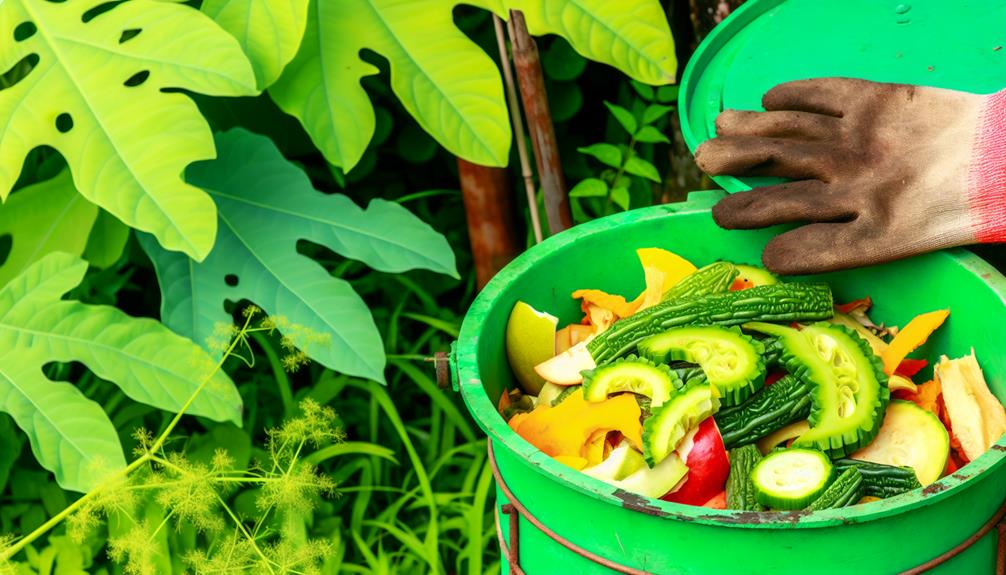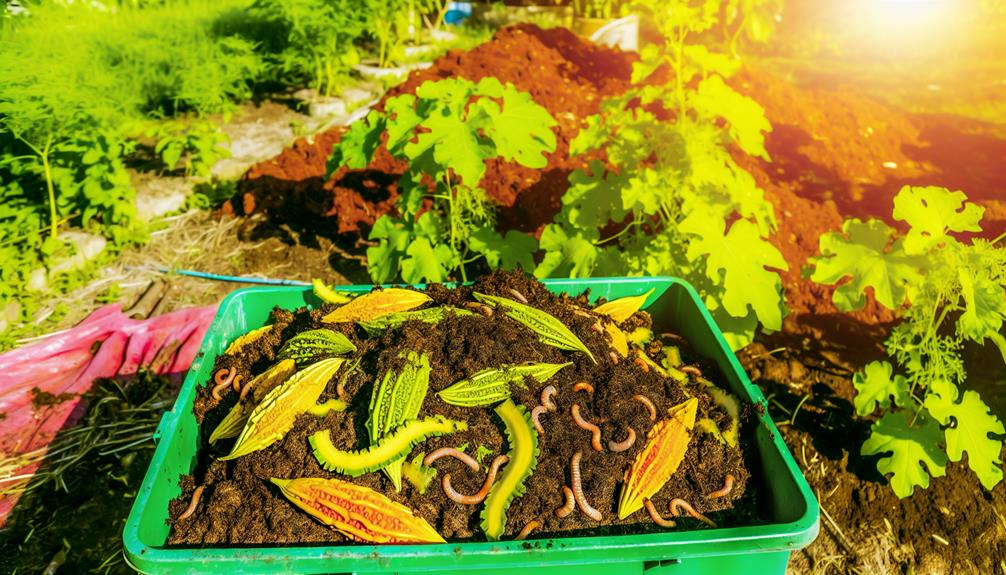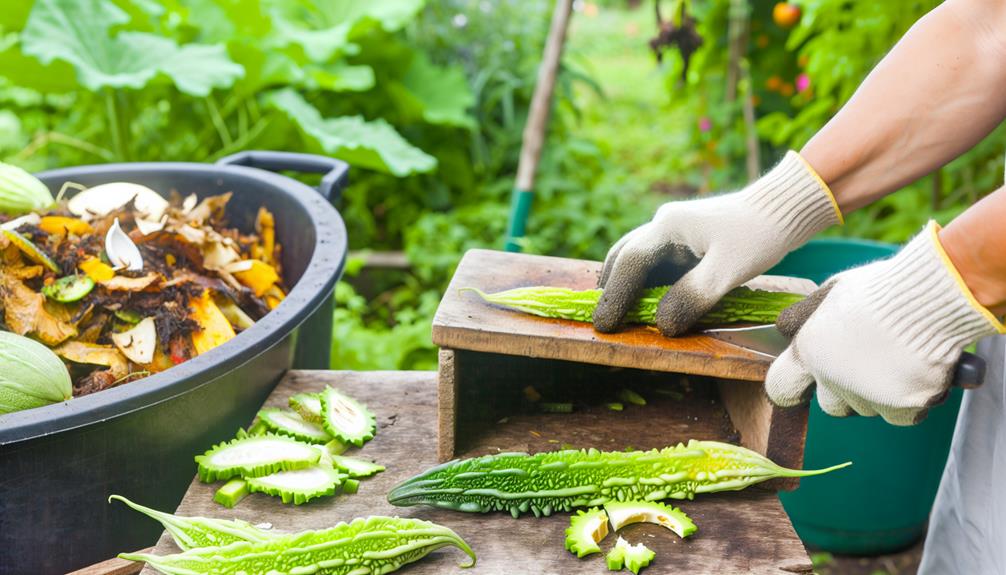

Yes, you can definitely compost bitter gourd! Adding bitter gourd to your compost provides essential nutrients that enrich your soil. Just chop it up into smaller pieces to speed up decomposition. Remember to balance it with carbon-rich materials like dry leaves or cardboard, keeping your compost pile moist but not waterlogged.
Regularly turning the pile guarantees proper aeration and quicker breakdown. Composting bitter gourd not only reduces waste but also enhances your garden’s soil structure and microbial activity. If you manage the balance and conditions right, you’ll be amazed at how beneficial it can be for your compost pile.
Bitter gourd is packed with essential nutrients like vitamins A and C, iron, and fiber that can enrich your compost. When you add bitter gourd to your compost pile, you’re not just disposing of kitchen waste; you’re enhancing the nutrient profile of your compost.
The vitamins help in the growth of beneficial microbes, vital for breaking down organic matter. Iron boosts plant health, aiding in robust root development. Fiber, on the other hand, improves the compost’s texture, making it more aerated and easier to turn.
To get started with composting, you need to understand how organic waste breaks down and the ideal conditions for this process.
You’ll also want a good list of compostable materials, ensuring you include items like fruit peels, vegetable scraps, and yard clippings.
When you start composting, understanding how organic waste breaks down is crucial for creating rich, healthy soil. Organic waste, like bitter gourd, decomposes through a natural process driven by microorganisms. These tiny helpers, including bacteria and fungi, break down the waste into smaller pieces, turning it into nutrient-rich compost.
You’ll need to regularly add a mix of green materials, like kitchen scraps, and brown materials, such as dried leaves, to maintain balance. This mixture guarantees that the microorganisms have the right environment to thrive. Regularly turning your compost pile adds oxygen, speeding up the breakdown process.
Achieving ideal compost conditions requires carefully managing the balance of green and brown materials, moisture, and aeration to create the perfect environment for microorganisms to thrive. You’ll need a mix of nitrogen-rich greens and carbon-rich browns. Keep the pile moist, but not soggy, like a wrung-out sponge. Turn the compost regularly to introduce oxygen, helping microbes break down materials faster.
Here’s a quick guide to help you balance your compost:
| Green Materials | Brown Materials | Ideal Conditions |
|---|---|---|
| Fruit scraps | Dry leaves | Moist like a sponge |
| Vegetable peels | Paper | Turn every 2 weeks |
| Coffee grounds | Cardboard | Warm temperatures |
| Grass clippings | Straw | Proper aeration |
| Manure | Sawdust | Microbial activity |
You can compost a wide variety of materials to create rich, fertile soil for your garden. By understanding what’s compostable, you can guarantee your compost remains balanced and effective.
Here’s a quick list of essentials:
Including a mix of these materials can help foster a healthy compost pile, turning your waste into a valuable garden resource. Remember, the more diverse your compost, the richer your garden soil will be.
Also Read: Can You Compost Wool?
Composting bitter gourd has fantastic benefits that you’ll love! It enriches your soil with essential nutrients, boosting plant growth and health.

Plus, it helps reduce waste, turning kitchen scraps into valuable compost instead of filling up landfills.
By adding composted bitter gourd to your soil, you’ll enrich it with essential nutrients that promote plant health and growth. This nutrient-rich addition helps create a thriving garden ecosystem.
Here are four key benefits of using composted bitter gourd:
Incorporating composted bitter gourd into your garden fosters a sense of community with nature, enhancing your gardening success.
Reducing kitchen waste is one of the primary benefits of composting bitter gourd. When you compost bitter gourd, you’re not just cutting down on waste; you’re also creating something valuable for your garden. Instead of tossing bitter gourd scraps in the trash, you can turn them into nutrient-rich compost that boosts your soil quality.
Here’s a quick look at the benefits:
| Benefit | Description | Impact |
|---|---|---|
| Waste Reduction | Less kitchen waste sent to landfills | Cleaner environment |
| Soil Enrichment | Adds nutrients to your compost | Healthier plants |
| Cost Savings | Reduces the need for store-bought fertilizers | Saves money |
Also Read: Can You Compost Cardboard Tubes?
One potential drawback you’ll face when composting bitter gourd is its high moisture content, which can lead to a soggy compost pile. This excess moisture can slow down the composting process and attract pests. To avoid this issue, you’ll need to maintain the health of your compost ingredients.
Here are four steps to guarantee your compost stays healthy:
To prep bitter gourd for composting, start by chopping it into smaller pieces to speed up decomposition. This step is important because it increases the surface area, allowing microorganisms to break down the organic material more effectively. You’ll want to use a sharp knife or a food processor to make sure of even cuts, making the bitter gourd easier to mix into your compost pile.

Once chopped, scatter the pieces across your compost bin, making certain they’re well-distributed. This helps integrate the bitter gourd with other compost materials, fostering a balanced environment for decomposition.
Also Read: Can You Compost Mail?
Achieving a well-balanced compost pile requires a mix of green and brown materials to maintain ideal decomposition. Green materials, like bitter gourd scraps, provide nitrogen, while brown materials, such as leaves, offer carbon. You’ll want to create a harmonious blend to make sure your compost pile thrives.
Follow this simple guide:
Now that you’ve got the basics down, let’s explore some practical composting tips to enhance your pile’s efficiency.
Start by chopping your bitter gourd and other kitchen scraps into smaller pieces; this speeds up decomposition.
Turn your compost regularly to aerate it, helping beneficial microbes thrive.
Add a diverse mix of green (nitrogen-rich) and brown (carbon-rich) materials, aiming for a balanced ratio.
Keep your compost moist, but not soggy, like a damp sponge.
Cover your pile to retain heat and moisture, which accelerates the composting process.
Finally, maintain a thermometer to monitor your pile’s temperature; it should stay between 135°F and 160°F for best breakdown.
Also Read: Can You Compost Tomato Puree?
Many gardeners make common mistakes that can hinder the composting process. Let’s make sure you avoid these pitfalls to keep your compost thriving.
By steering clear of these common mistakes, you set the stage for a successful composting journey with your bitter gourd waste. Embrace this eco-friendly practice, and you’ll not only reduce waste but also enrich your garden soil. Remember to maintain a good balance of green and brown materials, keep your compost pile moist but not waterlogged, and turn it regularly for proper aeration.
Here’s a quick guide to help you:
| Do’s | Don’ts | Tips |
|---|---|---|
| Add green materials | Avoid meat products | Shred large pieces |
| Balance with browns | Don’t add dairy | Turn your pile regularly |
| Keep moist | Skip oily foods | Monitor temperature |
| Turn periodically | No pet waste | Use a compost bin |
| Use diverse materials | Avoid chemicals | Be patient |
